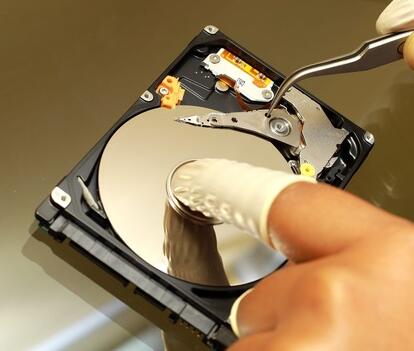Hard disks are critical components for storing digital data, but like all hardware, they are prone to failure. When a hard disk fails, the risk of data loss becomes very real and can have devastating implications for individuals and businesses alike. Failed hard disk data recovery involves attempting to retrieve data from a non-functional or partially functional storage device.
A failed hard disk is a drive that is no longer functioning correctly, either due to mechanical, electrical, or logical issues. This can render the data stored on it inaccessible. Failure can be partial (intermittent access) or complete (non-detectable by systems).

Types of Hard Disk Failures
Mechanical Failure
Caused by issues with internal components like the read/write heads, spindle motor, or platters.
Symptoms: Clicking noises, spinning up and down, or complete silence.
Electrical Failure
Resulting from a power surge or damaged PCB (printed circuit board).
Symptoms: No power, burning smell, or erratic behavior.
Logical Failure
Refers to corruption in the file system or firmware errors.
Symptoms: OS won’t boot, drive is recognized but shows no data.
Bad Sectors
Physical areas on the disk that are damaged and unreadable.
Symptoms: Slow performance, freezing during access, or file errors.
Common Causes of Hard Disk Failures
Age and Wear: Disks wear out over time due to regular use.
Power Surges: Electrical spikes can damage internal circuitry.
Overheating: Inadequate cooling or high environmental temperatures.
Physical Impact: Dropping or bumping the drive.
Manufacturing Defects: Flaws that manifest after prolonged use.
Improper Shutdowns: Sudden power losses can cause write errors.
Failed Hard Disk Recovery Process
Diagnosis
The first step involves identifying the type and extent of damage.
Labs use tools like PC-3000. multimeters, and imaging software.
Data Imaging
Creating a sector-by-sector clone of the disk to avoid further damage during attempts.
Critical for drives with deteriorating conditions.
Logical Repair or Hardware Intervention
Logical: Fixing file system or firmware issues.
Hardware: Replacing read/write heads, swapping PCB, or using donor drives.
Data Extraction
Once stabilized, data is extracted from the image.
Recovered files are stored on a secure medium (external drive, cloud, etc.).
Verification and Delivery
Integrity checks ensure files are functional.
Data is delivered with confidentiality and security protocols.
Challenges in Recovering Failed Hard Disks
Severe Physical Damage
Platter damage or dust contamination can render data irretrievable.
Encryption
Encrypted disks need the original keys or software environment.
Obsolete Technology
Older drives may require legacy hardware and software.
DIY Recovery Risks
Using software or mishandling a physically damaged disk can worsen the problem.
Cleanroom Requirement
Physical repairs must occur in ISO-certified cleanrooms to prevent contamination.
Professional vs. DIY Recovery
DIY Recovery
Works best for logical failures.
Tools: Recuva, TestDisk, EaseUS.
Risks: May overwrite data or worsen hardware damage.
Professional Recovery
Required for hardware damage or complex corruption.
Pros: Higher success rates, advanced tools, and cleanroom access.
Cons: Higher cost and turnaround time.
Cost of Failed Hard Disk Recovery
Diagnostics: Free to $150 depending on the provider.
Logical Recovery: $100 – $700
Mechanical Recovery: $700 – $2000+
Emergency Service: Extra charges for 24- to 48-hour turnaround
Factors influencing cost:
Drive size and type
Severity of failure
Parts availability (especially for older drives)
Urgency and data volume
Tips to Increase Recovery Success
Stop Using the Drive: Prevents further damage or overwriting.
Avoid DIY on Physically Damaged Disks: Only professionals should open a disk.
Label Symptoms Clearly: Helps technicians understand the issue.
Backup Regularly: Always maintain redundant data storage.
Handle with Care: Avoid heat, moisture, and shocks.
Case Examples
Enterprise Server Crash
RAID 10 failure from power surge
Rebuilt array and recovered 95% of data
Cost: $4200
Laptop Drive with Clicking Sound
Head crash on 500GB SATA drive
Donor parts used for replacement
Recovery rate: 88%
Cost: $1200
External Drive After Drop
Spindle seized, motor failed
Platter extraction in cleanroom
Recovery success: 60%
Cost: $1800
Preventing Hard Disk Failure
Use Surge Protectors: Prevents electrical damage
Maintain Ventilation: Avoid overheating
Run Disk Checks: Use S.M.A.R.T. tools regularly
Clone Drives Periodically: Ensures quick data replacement
Invest in Cloud or Redundant Backup Systems
Conclusion: Navigating Failed Hard Disk Recovery Wisely
While failed hard disk data recovery can be challenging and costly, understanding the process and risks can help you make better decisions. The key is early diagnosis, choosing the right recovery approach, and always backing up critical data. For physical damage or complex issues, rely on professional recovery services with cleanroom facilities and proven expertise. For logical failures or minimal risk cases, careful DIY attempts may suffice. Ultimately, the value of the data determines the path you should take.
About us and this blog
Panda Assistant is built on the latest data recovery algorithms, ensuring that no file is too damaged, too lost, or too corrupted to be recovered.
Request a free quote
We believe that data recovery shouldn’t be a daunting task. That’s why we’ve designed Panda Assistant to be as easy to use as it is powerful. With a few clicks, you can initiate a scan, preview recoverable files, and restore your data all within a matter of minutes.

 Try lt Free
Try lt Free Recovery success rate of up to
Recovery success rate of up to









